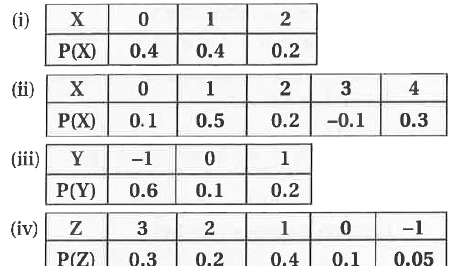Given that the events A and B are such that P(A)=12,P(A∩B)=35. And P(B )= p. Find p if they are (i) mutually exclusive (ii) independent.Solution in Gujrati
The correct Answer is:(i) p=110 (ii)p=15
Step by step video, text & image solution for Given that the events A and B are such that P(A)= (1)/(2), P( A cap B)= (3)/(5). And P(B )= p. Find p if they are (i) mutually exclusive (ii) independent. by Maths experts to help you in doubts & scoring excellent marks in Class 12 exams.
Updated on:21/07/2023Topper's Solved these Questions
- PROBABILITYBOOK - KUMAR PRAKASHANCHAPTER - PROBABILITYEXERCISE - EXERCISE -13.3
14 Videos
- PROBABILITYBOOK - KUMAR PRAKASHANCHAPTER - PROBABILITYEXERCISE - EXERCISE -13.4
20 Videos
- PROBABILITYBOOK - KUMAR PRAKASHANCHAPTER - PROBABILITYEXERCISE - EXERCISE -13.1
23 Videos
- MATRICES BOOK - KUMAR PRAKASHANCHAPTER - MATRICES EXERCISE - Practice Paper - 3 (Section - D)
1 Videos
- RELATIONS AND FUNCTIONS BOOK - KUMAR PRAKASHANCHAPTER - RELATIONS AND FUNCTIONS EXERCISE - Practice Paper - 1 (Section - D)
2 Videos
Similar Questions
An urn contains 5 red and 5 black balls. A ball is drawn at random, its colour is noted and is returned to the urn. Moreover, 2 additional balls of the colour drawn are put in the urn and then a ball is drawn at random. What is the probability that the second ball is red?
View SolutionState which of the following are not the probability distributions of a random variable. Give reasons for your answer.

View SolutionGiven that E and F are events such that P(E)=0.6,P(F)=0.3and(E∩F)=0.2, find P(E|F) and P(F|E)
View SolutionFor matrix A=⎡⎢⎣11112−32−13⎤⎥⎦ . Prove that , A3−6A2+5A+11I=0. Hence find A−1 using it .
View SolutionLet : f:N→N be defined by f(n)={n+12 if n is oddn2 if n is even for all n∈N .
State whether the function f is bijective . Justify your answer.
View SolutionGiven that the events A and B are such that P(A)=12, P(A∩B)=35and P(B)=p. Find p if they are (i) mutually exclusive (ii) independent.
View SolutionIf A and B are two events such that P(A)=12,P(A∪B)=35 and P(B)=p, then find the value of p when:
(i) A and B are mutually exclusive
(ii) A and B are independent events.
View SolutionA और B ऐसी घटनाएं दी गई है जहां P(A)=12,P(A∪B)=35 तथा P(B)=p. p का मान ज्ञात कीजिए यदि (i) घटनाएं परस्पर अपवर्जी हैं। (ii) घटनाएं स्वतंत्र हैं।
View SolutionP(A)=35औरP(B)=15 दिया गया हैं । यदि A और B परस्पर अपवर्जी घटनाएँ हैं , तो P ( A या B ) ज्ञात कीजिए ।
View Solutionयदि A तथा B ऐसी घटनाएँ है कि P(A)=12,P(A∪B)=35 तथा P(B')=p.p का मान ज्ञात कीजिए, यदि (a) घटनाएँ परस्पर अपवर्जी है, (b) घटनाएँ परस्पर स्वतंत्र है |
View SolutionGiven P(A) =35andP(B)=15 . Find P(A or B), if A & B are mutually exclusive events.
View SolutionGiven that the events A and B are such that P(A)=12,P(A∪B)=35 and P(B) = p. Find p if they are (i) mutually exclusive, (ii) independent.
View SolutionGiven that the events A and B are such that P(A) = (1)/(2), P(A cup B)=(3)/(5) and P(B) = p. Find p if they are (i) mutually exclusive (ii) independent.
View SolutionGiven that the events A and B are such that P(A)=12,P(A∪B)=35 and P(B) = p. Find p if they are (i) mutually exclusive (ii) independent.
View SolutionGiven that the events A and B are such that P(A)=12,P(A∪B)=35 and P(B) = p. Find p if they are (i) mutually exclusive (ii) independent.
View Solution
